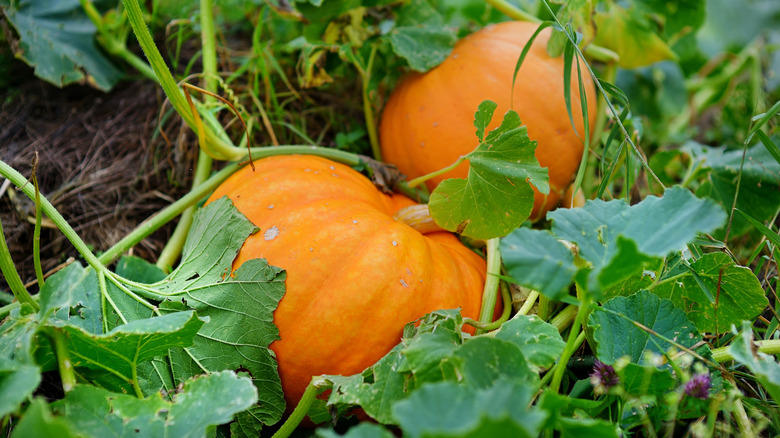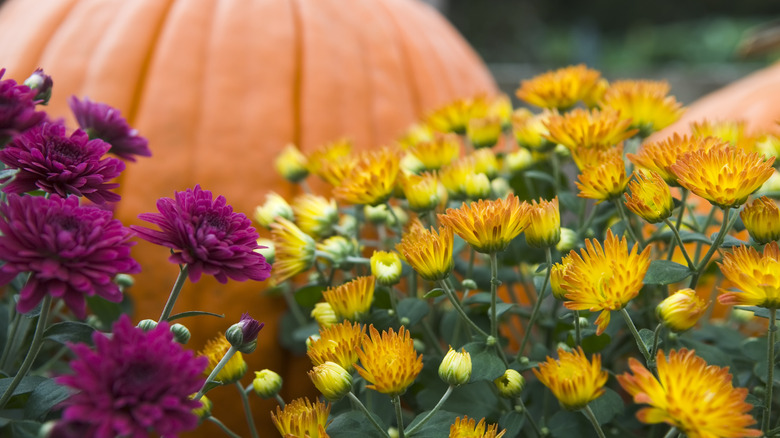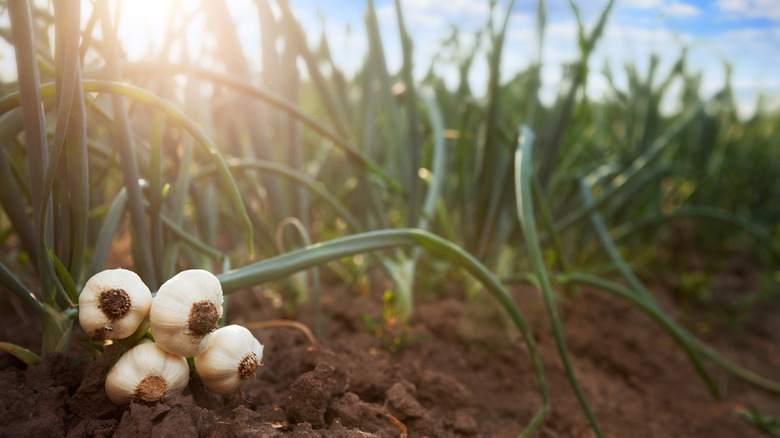Why Pumpkins And Garlic Aren't Friendly In The Garden
Both beloved garden staples, pumpkins and garlic are enjoyed by many garden enthusiasts and home chefs alike, but unfortunately, these two plants are best not planted together due to their distinct ideal growing conditions. For starters, pumpkins thrive in nutrient-rich soil with ample space for their sprawling vines. They require consistent moisture and sunlight to produce large, healthy future Jack-o-lanterns. In contrast, garlic prefers well-draining soil with less nitrogen and requires a period of dryness to develop flavorful bulbs. These two conditions do not pair so well.
When grown in close proximity, pumpkins can overshadow garlic plants, limiting their access to sunlight with their large leaves and inhibiting their growth. The competition for nutrients and water could lead to less-than-ideal development for both crops. Moreover, garlic's characteristic pungent flavor, which is great for certain meals, can be compromised when sharing the same soil and space as pumpkins, potentially affecting the taste of both vegetables.
Additionally, pumpkins tend to spread vigorously, potentially overtaking garlic patches and making it challenging to harvest the bulbs properly. Proper spacing and companion planting considerations are necessary for a harmonious garden. To ensure optimal growth and flavor, it's better to separate pumpkins and garlic, allowing each plant to thrive under its preferred conditions without negatively impacting taste, growth, and harvest outcomes.
Companion plants for pumpkins
Companion planting with pumpkins involves selecting plants that provide mutual benefits through various mechanisms like pest control, nutrient enhancement, and space utilization. Marigolds, known for their vibrant flowers, serve as natural pest repellents due to their strong aroma. Their scent helps deter pests like aphids, nematodes, and beetles, which can otherwise harm pumpkin vines. Marigolds also attract beneficial insects like ladybugs and parasitic wasps that prey on common pumpkin pests. Their presence minimizes the need for chemical solutions, promoting a healthier and more natural garden ecosystem.
Corn serves as an excellent companion due to its structural benefits. Its tall stalks provide vertical support for pumpkin vines, allowing them to grow upward rather than sprawling across the ground. This vertical growth helps to better air circulation, reducing the risk of fungal diseases that often affect pumpkins when their foliage remains damp. In turn, pumpkin vines offer shade to the soil around the corn, conserving soil moisture and promoting healthier growth.
Beans, specifically pole beans, form a symbiotic relationship with pumpkins. They are nitrogen-fixing plants, which means they draw nitrogen from the air and convert it into a form that enriches the soil. Pumpkins, as heavy feeders, benefit from the increased nitrogen content in the soil provided by the beans. In return, pumpkin vines can offer a climbing structure for the beans, creating additional supports. This interdependence results in healthier pumpkins with better nutrient availability and enhanced soil fertility.
Companion plants for garlic
Chamomile is a fantastic companion for garlic due to its pest-repelling properties. It emits a pleasant fragrance that deters pests like aphids, beetles, and flies, helping to protect garlic from potential infestations. Additionally, chamomile's low-growing habit doesn't compete for space with the taller garlic plants, ensuring that both can flourish without overcrowding.
Lettuce is another suitable companion for garlic. Its shallow root system and fast growth make it an excellent choice for interplanting with garlic. The lettuce leaves provide shade for the soil, helping to keep it cool and moist, which is beneficial for the shallow-rooted garlic plants. Furthermore, lettuce can act as a living mulch, preventing weed growth around the garlic bulbs while adding an extra layer of protection against soil erosion.
Finally, carrots also work well as companions for garlic. Their growth habit complements that of garlic, as carrots develop underground while garlic grows above ground. This allows for efficient space utilization without competing for sunlight or nutrients. Carrots also help break up the soil structure, which can improve drainage around the garlic bulbs and prevent waterlogging, a condition that garlic dislikes. As a bonus, the scent of carrots can help mask the smell of garlic, potentially confusing pests that might otherwise target the garlic plants.


